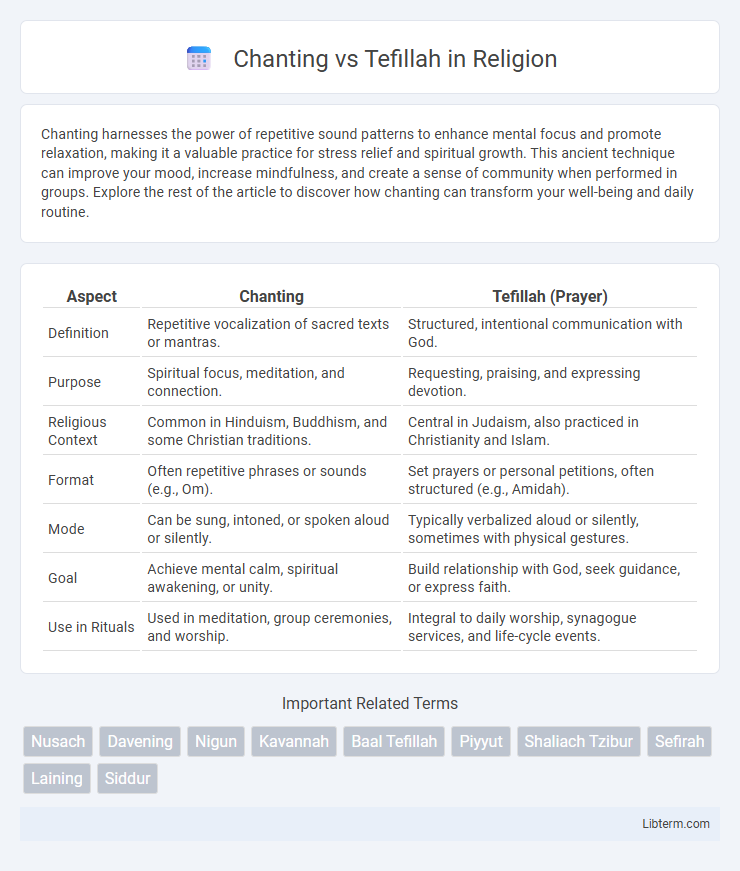Chanting harnesses the power of repetitive sound patterns to enhance mental focus and promote relaxation, making it a valuable practice for stress relief and spiritual growth. This ancient technique can improve your mood, increase mindfulness, and create a sense of community when performed in groups. Explore the rest of the article to discover how chanting can transform your well-being and daily routine.
Table of Comparison
| Aspect | Chanting | Tefillah (Prayer) |
|---|---|---|
| Definition | Repetitive vocalization of sacred texts or mantras. | Structured, intentional communication with God. |
| Purpose | Spiritual focus, meditation, and connection. | Requesting, praising, and expressing devotion. |
| Religious Context | Common in Hinduism, Buddhism, and some Christian traditions. | Central in Judaism, also practiced in Christianity and Islam. |
| Format | Often repetitive phrases or sounds (e.g., Om). | Set prayers or personal petitions, often structured (e.g., Amidah). |
| Mode | Can be sung, intoned, or spoken aloud or silently. | Typically verbalized aloud or silently, sometimes with physical gestures. |
| Goal | Achieve mental calm, spiritual awakening, or unity. | Build relationship with God, seek guidance, or express faith. |
| Use in Rituals | Used in meditation, group ceremonies, and worship. | Integral to daily worship, synagogue services, and life-cycle events. |
Understanding Chanting and Tefillah: Definitions and Origins
Chanting refers to the rhythmic intonation of spiritual or religious texts, often used in various religious traditions to enhance meditation and communal worship. Tefillah, a Hebrew term, denotes a prayer that involves heartfelt communication with God, deeply rooted in Jewish liturgical practice and the Torah's commandments. Both practices share origins in ancient religious customs, with chanting emphasizing melodious recitation and tefillah focusing on structured, intentional prayer.
Historical Evolution of Chanting in Jewish Practice
Chanting in Jewish practice traces back to ancient Temple rituals where Levites intoned Psalms using specific melodic patterns integral to sacred worship. Over centuries, this evolved into distinct regional nuschaot (prayer traditions), embedding precise cantillation marks (ta'amim) that guided Torah reading and prayer chanting. This historical trajectory highlights chanting as a foundational element that shaped the formal structure and spiritual experience of Tefillah in diverse Jewish communities.
The Role of Tefillah in Jewish Spirituality
Tefillah, the traditional Jewish prayer, serves as a direct communication channel between individuals and God, fostering spiritual connection and introspection in Jewish practice. Unlike chanting, which emphasizes melodic repetition and can function as a meditative or ritualistic tool, tefillah integrates structured prayers with specific blessings and intentions to fulfill religious commandments and express heartfelt devotion. This sacred practice reinforces communal identity, cultivates gratitude, and elevates the soul by aligning daily life with divine will and ethical values in Jewish spirituality.
Structural Differences: Chanting vs. Traditional Tefillah
Chanting in Jewish practice emphasizes melodic repetition and rhythmic patterns, often using tefillah texts in a more musical and flowing manner. Traditional tefillah follows a fixed liturgical structure with specific prayers recited in a set order, prioritizing precise wording and halachic requirements. The structural difference lies in chanting's flexibility and improvisational style, contrasting with the formal, scripturally anchored sequence of traditional tefillah.
Musicality and Melody: The Soundscapes of Jewish Worship
Chanting in Jewish worship emphasizes traditional melodic phrases rooted in ancient modes, creating a solemn and meditative soundscape that enhances communal prayer. Tefillah incorporates a broader musicality, blending varied tunes and personal melodies that reflect regional and cultural diversity, fostering deeper emotional connections. Both chanting and tefillah use melody to transform text into living spiritual experiences, with chanting often following strict cantillation marks and tefillah allowing more melodic flexibility.
Communal vs. Individual Expression in Prayer
Chanting in prayer often serves as a communal expression, uniting participants through synchronized melodies and shared liturgical traditions that enhance collective spiritual experience. In contrast, tefillah emphasizes individual connection with the Divine, allowing personal intention and introspection to shape the prayer's emotional depth. Both forms complement each other by balancing community cohesion with private devotion, enriching the overall practice of Jewish prayer.
Emotional and Spiritual Impact: Chanting vs. Tefillah
Chanting creates a rhythmic, meditative state that enhances emotional release and spiritual connection through repetitive sounds and vibrations. Tefillah, rooted in structured prayer and personal intention, fosters deeper introspection, emotional sincerity, and a direct relationship with the Divine. Both practices evoke profound spiritual experiences, yet chanting emphasizes collective energy and mood transformation, while tefillah centers on individual communion and heartfelt devotion.
Ritual Contexts: When is Chanting Preferred Over Tefillah?
Chanting is preferred over tefillah in ritual contexts that emphasize communal participation and melodic expression, such as during the Torah reading and Psalms recitation in synagogue services. Chanting enhances the spiritual atmosphere by using traditional melodies that facilitate collective focus and connection to sacred texts. In contrast, tefillah, often more personal and structured, is favored in private prayer and formal liturgical settings.
Modern Adaptations: Blending Chanting with Tefillah
Modern adaptations of Jewish prayer incorporate chanting techniques to enhance the spiritual experience of tefillah, blending traditional melodic patterns with contemporary tunes. This fusion leverages the meditative qualities of chanting, enriching communal prayer and personal devotion by making tefillah more accessible and emotionally resonant. Innovations in music technology and diverse cultural influences have further expanded the variety of chant-inspired tefillah practices in synagogues worldwide.
Choosing Your Path: Personalizing Jewish Prayer Practices
Choosing between chanting and tefillah allows individuals to personalize their Jewish prayer experience based on spiritual needs and communal traditions. Chanting, with its melodic and rhythmic patterns, enhances emotional engagement and helps in memorizing sacred texts, while tefillah offers a more personal, introspective approach to prayer. Integrating both practices can deepen spiritual connection and accommodate diverse expressions of faith within Jewish worship.
Chanting Infographic

 libterm.com
libterm.com